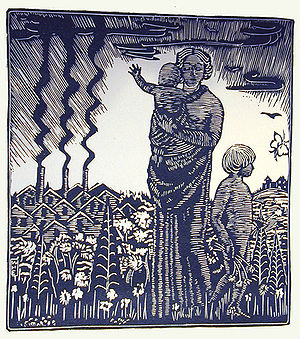
Wharton Esherick
Encyclopedia


Born in Philadelphia, Esherick studied painting at the Philadelphia Museum School of Industrial Arts (now the University of the Arts (Philadelphia)
University of the Arts (Philadelphia)
The University of the Arts is one of the United States' oldest universities dedicated to the arts. Its campus makes up part of the Avenue of the Arts in Center City, Philadelphia...
) and at the Pennsylvania Academy of the Fine Arts
Pennsylvania Academy of the Fine Arts
The Pennsylvania Academy of the Fine Arts is a museum and art school in Philadelphia, Pennsylvania. It was founded in 1805 and is the oldest art museum and school in the United States. The academy's museum is internationally known for its collections of 19th and 20th century American paintings,...
. In 1913 he moved to a farmhouse near Paoli, Pennsylvania to pursue his painting career. He began carving decorative frames for his paintings in 1920, which led to making woodcut prints and finally to sculpture.
Esherick’s early furniture was derived from the Arts and Crafts
Arts and Crafts movement
Arts and Crafts was an international design philosophy that originated in England and flourished between 1860 and 1910 , continuing its influence until the 1930s...
style, and decorated with surface carving. In the late 1920s he abandoned carving on his furniture, focusing instead on the pure form of the pieces as sculpture. In the 1930s he was producing sculpture and furniture influenced by the organicism of Rudolf Steiner
Rudolf Steiner
Rudolf Joseph Lorenz Steiner was an Austrian philosopher, social reformer, architect, and esotericist. He gained initial recognition as a literary critic and cultural philosopher...
, as well as by German Expressionism
German Expressionism
German Expressionism refers to a number of related creative movements beginning in Germany before the First World War that reached a peak in Berlin, during the 1920s...
and Cubism. The angular and prismatic forms of the latter two movements gave way to the free-form curvilinear shapes for which he is best known.
From furniture and furnishings, he progressed to interiors, the most famous being the Curtis Bok House
Curtis Bok
William Curtis Bok was a Pennsylvania jurist, philanthropist and writer. Heir to an enormous fortune, he was also a devout Quaker and an avid sailor.-Biography:...
(1935–37). Though the house was demolished, Esherick’s work was saved. The fireplace and adjacent music room doors can be seen in the Philadelphia Museum of Art
Philadelphia Museum of Art
The Philadelphia Museum of Art is among the largest art museums in the United States. It is located at the west end of the Benjamin Franklin Parkway in Philadelphia's Fairmount Park. The Museum was established in 1876 in conjunction with the Centennial Exposition of the same year...
and the foyer stairs can be seen in the Wolfsonian Museum in Miami, Florida.
In 1940, George Howe (architect)
George Howe (architect)
George Howe was an American architect and educator, and an early convert to the International style. With William Lescaze, he designed Philadelphia's PSFS Building .-Biography:...
used Esherick’s Spiral Stair (1930) and Esherick furniture to create the “Pennsylvania Hill House” exhibit in the New York World’s Fair “America at Home” Pavilion. Esherick’s work was also featured in a 1958 retrospective at the Museum of Contemporary Craft and in the 1972 “Woodenworks” exhibition at the Renwick Gallery
Renwick Gallery
The Renwick Gallery is a branch of the Smithsonian American Art Museum, located in Washington, D.C., and focuses on American craft and decorative arts from the 19th century to the 21st century...
. He exhibited hundreds of times during his life and his work is now in the collections of the Philadelphia Museum of Art, the Metropolitan Museum in New York, the Whitney Museum in New York, the Pennsylvania Academy of the Fine Arts and many other museums. Most of his work remains in private hands.
His greatest creation was his home and studio, outside of Valley Forge, Pennsylvania. The buildings evolved over forty years as Esherick lived and worked there. He continued working on the studio until his death in 1970. In 1972 the studio was converted into the Wharton Esherick Museum. The property, known as Wharton Esherick Studio
Wharton Esherick Studio
Wharton Esherick Studio, now housing the Wharton Esherick Museum, was the studio of the craftsman-artist Wharton Esherick , in Malvern, Pennsylvania...
, was declared a National Historic Landmark
National Historic Landmark
A National Historic Landmark is a building, site, structure, object, or district, that is officially recognized by the United States government for its historical significance...
in 1993.
Esherick was the father of Ruth Bascom, architect Mansfield Bascom and uncle of American architect Joseph Esherick
Joseph Esherick
Joseph Esherick was an American architect.Esherick was born in Philadelphia, Pennsylvania. Graduating from the University of Pennsylvania in 1937, Esherick set up practice in the San Francisco Bay Area in 1953 and taught at University of California, Berkeley for many years...
.

